
Public bronze sculptures are valuable cultural and artistic assets, often targeted by thieves and vandals. To safeguard these pieces, various anti-theft anchors are employed. Here are the most common types:
1. Expansion Anchors: These are embedded into the sculpture's base and expand when tightened, creating a secure grip in concrete or stone. They are durable and resistant to tampering.
2. Chemical Anchors: Using epoxy or resin, these anchors bond the sculpture to its foundation, providing a strong, invisible hold. They are ideal for delicate or historic pieces.
3. Threaded Rods: Heavy-duty rods are drilled into the sculpture and foundation, then secured with nuts and plates. This method is highly visible but extremely effective.
4. Cable Systems: Stainless steel cables loop through the sculpture and anchor points, offering flexibility and strength. They are often used for larger or freestanding pieces.
5. Ground Spikes: These are driven deep into the ground and attached to the sculpture's base, making removal difficult without specialized tools.
Each method has its advantages, depending on the sculpture's size, location, and vulnerability. Combining multiple techniques can enhance security further. By investing in robust anti-theft measures, communities can preserve their public art for future generations.

